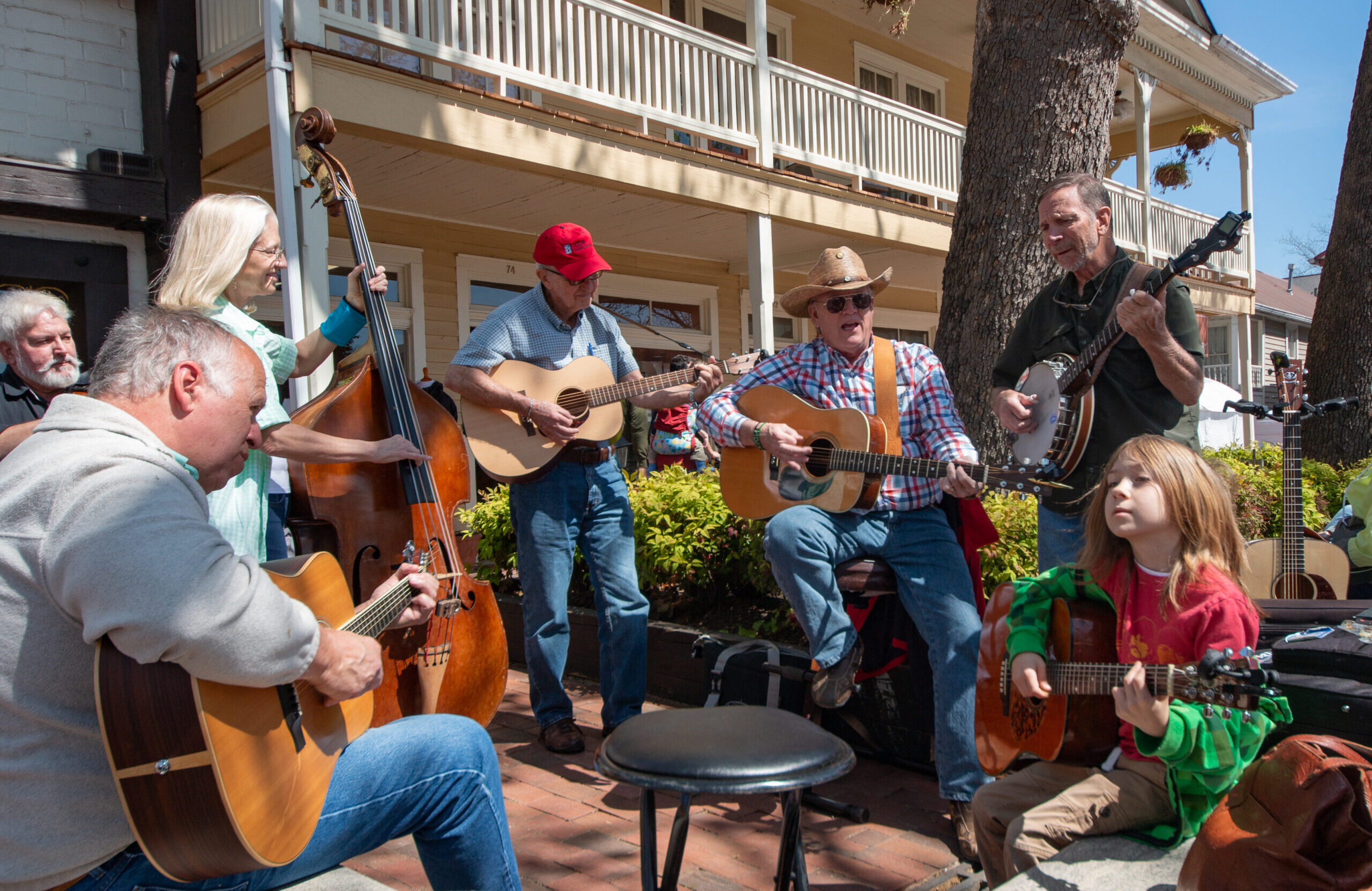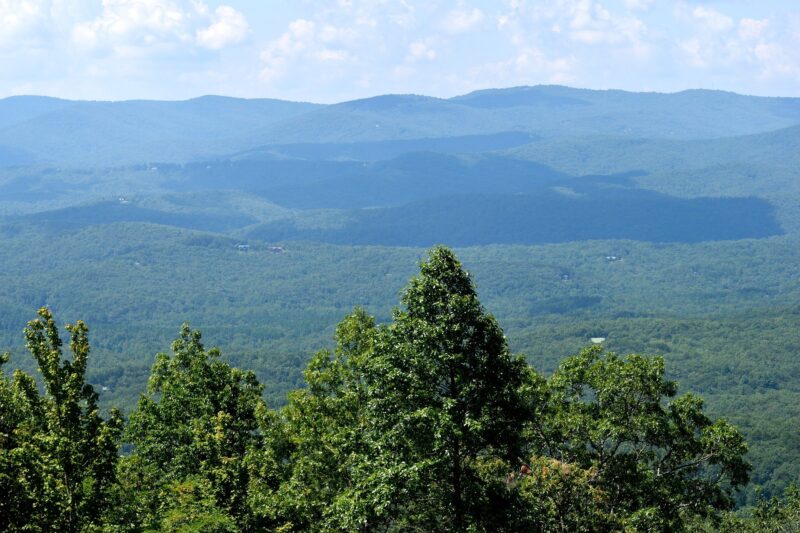There’s Music in Them There Hills…
Drive seventy-five miles north of Atlanta on Highway 400, up South Chestatee Street, just over Findley Ridge, and the peaks of blue mountains come into view. We are entering Dahlonega—a small town in north Georgia, at the base of the Appalachian Mountains. Further down the road, the town square becomes visible. At the center of the square stands the historic courthouse, now the Dahlonega Gold Museum. On Saturday afternoons, during the warmer part of the year, the sound of music floats out from a white EZ tent set up in front of the museum. People sitting in a circle play banjo, mandolin, guitar, fiddle, and bass. Sometimes a harmonica is in someone’s hands. Throughout the afternoon, many songs fill the tent. The fiddler’s bow blurs on tunes that are played at breakneck speed, so fast it’s hard to keep up with your tapping foot. Steadier gospel songs are popular with listeners sitting in blue and red camp chairs outside of the tent, who join in singing on the chorus. Some musicians have just met that afternoon, others share relationships that go back several decades. More than anything, there is an openness to all participants, and new players join the jam throughout the afternoon. That is the nature of the music: intergenerational, flexible—a medium that facilitates the encounters and exchanges of people from many places.

Jam at Bear on the Square Mountain Festival (credit: Herman Thompson)
Music by Migration
The sounds that make up Appalachian music began to coalesce over three hundred years ago, when many groups of people and their musical traditions converged in the region. Several waves of European immigrant settlers from countries including Ireland, England, Scotland and Germany arrived in the eighteenth century. Those seeking better jobs, land, and other opportunities also brought their musical traditions: dance tunes like reels and hornpipes, ballads, and sacred hymns. Music of Appalachia also cannot be separated from the transatlantic slave trade, which forced millions of Africans across the Atlantic Ocean and into enslavement (enslaved Africans first arrived in colonial Virginia in 1619). Their music persisted through the oral tradition, which is the passing of songs from one generation to the next without the aid of written words or tablature, by ear. Call-and-response singing, dance rhythms, instruments related to the banjo, and the old-time clawhammer banjo playing style are West African in origin and foundational to Appalachian music. Blues playing and singing is another major African American music form. Native Americans have helped carry on the Appalachian music tradition as well, such as Manco Sneed (1885-1975), a Cherokee fiddler who lived the majority of this life on the Cherokee tribal lands of the Qualla Boundary in western North Carolina.

Local migrations have shaped the sounds of Appalachian music as well. Industrialization at the turn of the twentieth century swept people from rural to urban areas. Atlanta, now an hour-and-a-half drive from Dahlonega, became a new home for north Georgians seeking jobs at textile mills. Others migrated from the South entirely, moving to the Midwest and the West Coast. The musical traditions that people brought with them stayed alive and evolved to reflect their new experiences, and with the advent of recorded music and radio, enabled the expression of this music well beyond local areas. Not everyone had the opportunity to be recorded. Those who did, however, were heard far beyond the region—inspiring listeners throughout the world to learn the music themselves. Those who were not recorded have influenced music in significant ways as well. As musicians of the future, it’s important to seek out their stories and represent all who have been at music’s crossroads.
Appalachian Music Today
Today, genres of Appalachian music include old-time, bluegrass, gospel, country, blues, and ballad-singing. Each has unique aspects of instrumentation, style, and repertoire, and expresses different stories and emotions. Some songs are about universal experiences like love or loss, while others recount specific events like an adventure in a new place. Song lyrics may be changed to fit the personal style, experience, or values of the performer. These are choices that musicians have a right and responsibility to consider in their performance. Through it, experiences represented by Appalachian music can be adapted to new contexts and build community.
The ways to learn about Appalachian music have grown over the years. Technologies like records, radio, and the Internet have transformed the ways that people listen to and learn music. Learning from people by the oral tradition continues to be central—you might pick up some tunes by playing in a band for a square dance on Saturday night, or learn songs that a bluegrass gospel band plays in church on Sunday morning. Larger gatherings of musicians at music festivals and fiddlers’ conventions are rich places for learning and sharing music as well. Every third weekend of April, Dahlonega’s streets fill with people, music, and art at the Bear on the Square Mountain Festival. It’s almost impossible to keep track of the number of jams throughout the square, not to mention workshops and concerts of performers from throughout the region. Some of the same musicians you will hear at Bear on the Square teach at Georgia Pick & Bow Traditional Music School, which teaches Appalachian music to local 4th-12th graders in north Georgia. In any of the settings where you hear Appalachian music, you’ll never know who will show up, and what you might learn there.
Pick & Bow performance at Dahlonega First Night (2017)
REFERENCES
“African American Song.” The Library of Congress. Accessed January 11, 2021.
“Appalachian Music.” The Library of Congress. Accessed January 11, 2021.
“Historic Artist: Manco Sneed.” Blue Ridge National Heritage Area. Accessed January 11, 2021.
Huber, Patrick. “Preface.” In Linthead Stomp: The Creation of Country Music in the Piedmont South, xiii-xxi. Chapel Hill, North Carolina: The University of North Carolina Press, 2014.
Owen, Blanton. “Manco Sneed and the Indians.” Field Recorders Collective, May 9, 2015.
“Roots of African American Music.” Smithsonian Institution. Accessed January 11, 2021.
